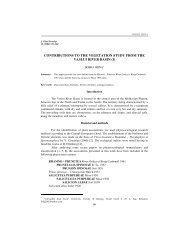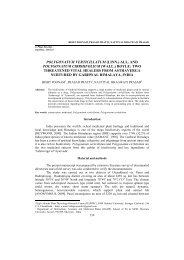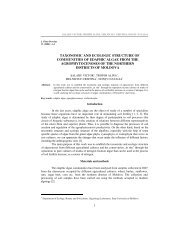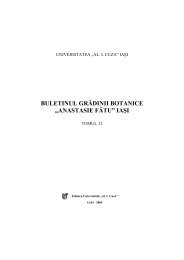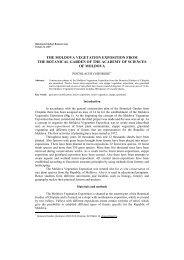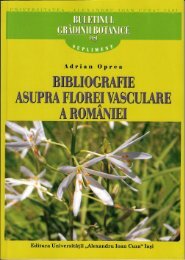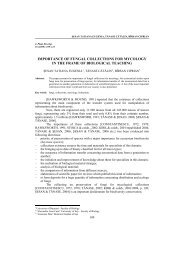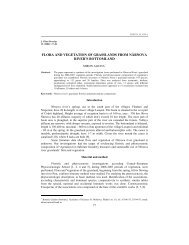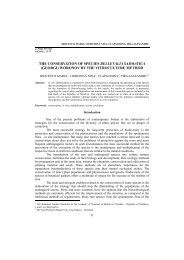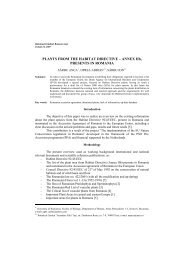ex situ conservation of saussurea porcii degen in y. fedkovych ...
ex situ conservation of saussurea porcii degen in y. fedkovych ...
ex situ conservation of saussurea porcii degen in y. fedkovych ...
You also want an ePaper? Increase the reach of your titles
YUMPU automatically turns print PDFs into web optimized ePapers that Google loves.
DEREVENKO TATIANA<br />
J. Plant Develop.<br />
18(2011): 151-157<br />
EX SITU CONSERVATION OF SAUSSUREA PORCII DEGEN IN Y.<br />
FEDKOVYCH NATIONAL UNIVERSITY BOTANIC GARDEN<br />
DEREVENKO TATIANA 1<br />
Abstract:<br />
The International Agenda for Botanic Gardens <strong>in</strong> Conservation emphasizes on <strong>conservation</strong> <strong>of</strong> rare<br />
species <strong>ex</strong> <strong>situ</strong> as the ma<strong>in</strong> task and its aim is the creation <strong>of</strong> a reserve stock for the possibility <strong>of</strong><br />
active recovery <strong>in</strong> nature. We have <strong>in</strong>troduced <strong>in</strong> the culture and first have been studied rhythm <strong>of</strong><br />
phenological development and flower<strong>in</strong>g, depend<strong>in</strong>g on weather conditions, seed production and<br />
added guidel<strong>in</strong>es for breed<strong>in</strong>g the endangered Eastern Carpathians endemic species - Saussurea<br />
<strong>porcii</strong> Degen, which is listed <strong>in</strong> the Red Data Book <strong>of</strong> Ukra<strong>in</strong>e and the European List <strong>of</strong> Globally<br />
Threatened Animals and Plants. We have created a field bank S. <strong>porcii</strong> – it is our contribution to the<br />
<strong>conservation</strong> <strong>of</strong> plant diversity.<br />
Key words: Saussurea <strong>porcii</strong> Degen, <strong>ex</strong> <strong>situ</strong> <strong>conservation</strong>, Red Data Book <strong>of</strong> Ukra<strong>in</strong>e, a field bank, the biology<br />
<strong>of</strong> develop<strong>in</strong>g<br />
Introduction<br />
The Global Strategy for Plant Conservation states that the <strong>conservation</strong> <strong>of</strong> liv<strong>in</strong>g<br />
plants collections <strong>of</strong> endangered species <strong>of</strong> regional floras, especially endemics, as the most<br />
vulnerable is very important. [GLOBAL STRATEGY FOR PLANT CONSERVATION,<br />
2002]. From the Carpathian region`s 219 endemic taxons [ТАСЄНКЕВИЧ, 2006] <strong>in</strong> the<br />
collections <strong>of</strong> CHNU Botanic Garden today are saved specimens <strong>of</strong> 11. Saussurea <strong>porcii</strong><br />
Degen is the Eastern Carpathians endemic, which has the phylogenetic relationships <strong>of</strong><br />
Siberia. In Ukra<strong>in</strong>e it is distributed <strong>in</strong>: Chornogora mounta<strong>in</strong> range (Polonyna Rogneska,<br />
ur. Primaratik), the upper Chornyi and Bilyi Cheremosh (Mounta<strong>in</strong> Gnetesa, polonyna<br />
Glystuvata, between polonynas Glystuvata and Preluky). In Romanian Carpathians it has<br />
been cited from the Maramureşului Mounta<strong>in</strong>s (at Borşa and Lanul Cercănel<br />
[ŞTEFUREAC, 1971], and <strong>in</strong> Rodna Mounta<strong>in</strong>s (on the Mounta<strong>in</strong> <strong>of</strong> Corongiş, under the<br />
rocks called “Porţii”, as well as on the opposite slope <strong>of</strong> it [ŞTEFUREAC, 1971;<br />
NYÁRÁDY, 1933]. This species is listed as disappear<strong>in</strong>g <strong>in</strong>to the Red Data Book <strong>of</strong><br />
Ukra<strong>in</strong>e [ДІДУХ, 2009], as critically endangered (CR) <strong>in</strong> Ukra<strong>in</strong>e and as <strong>ex</strong>t<strong>in</strong>ct (EX) <strong>in</strong><br />
Romania – accord<strong>in</strong>gly to the Red Data Book <strong>of</strong> Carpathians [ТАСЄНКЕВИЧ, 2002], as<br />
endangered (EN), <strong>in</strong> the European List <strong>of</strong> Globally Threatened Animals and Plants (1991).<br />
Today are known only 6 populations <strong>of</strong> S. <strong>porcii</strong> <strong>in</strong> the Carpathian Mounta<strong>in</strong>s [БАГЛЕЙ &<br />
ДАНИЛИК, 2009], mostly on wetlands <strong>in</strong> the crooked green alder <strong>in</strong> the subalp<strong>in</strong>e zone. It<br />
needs to establish reserves to protect it. Basically, it has a small populations number<strong>in</strong>g<br />
1 Yuriy Fedkovych Chernivtsi National University Botanic Garden, Fedkovych 11, 58022, Chernivtsi – Ukra<strong>in</strong>e,<br />
e-mail: tderevenko@ua.fm<br />
151
EX SITU CONSERVATION OF SAUSSUREA PORCII DEGEN IN Y. FEDKOVYCH NATIONAL …<br />
from 400 to 1000 <strong>in</strong>dividuals. The most numerous one has several thousand <strong>in</strong>dividuals and<br />
occupy<strong>in</strong>g an area <strong>of</strong> several tens <strong>of</strong> hectares on the polonyna Glystuvata (the Chyvchyn<br />
Mounta<strong>in</strong>s) (Fig. 1). Only this population from all has a high level vitality constituent<br />
<strong>in</strong>dividuals (Fig. 2) [БАГЛЕЙ, 2011].<br />
Currently, only CHNU Botanic Gardens liv<strong>in</strong>g collection present some specimens<br />
<strong>of</strong> S. <strong>porcii</strong>, unlike all the botanical gardens <strong>of</strong> Ukra<strong>in</strong>e [ЛЕБЕДА, 2011].<br />
Material and methods<br />
Saussurea <strong>porcii</strong> Degen is a hemikryptophyte, herbaceous perennial plant, to 80<br />
cm height, with sessile lanceolate leaves, form<strong>in</strong>g w<strong>in</strong>gs along the stem and <strong>in</strong>florescence<br />
corymbose. From polonyna Glystuvata locality the plant<strong>in</strong>g material has been <strong>in</strong>troduced<br />
CHNU Botanic Gardens, <strong>in</strong> 2007. In the Botanic Garden a place <strong>in</strong> partial shade for<br />
plant<strong>in</strong>g S. <strong>porcii</strong>, and a high soil moisture provided by regular water<strong>in</strong>g this populationlocus<br />
was chosed (Fig. 3).<br />
Monitor<strong>in</strong>g the phenological stages was carried out by conventional methods,<br />
recommended by the Botanical Gardens <strong>of</strong> USSR Council [МЕТОДИКА<br />
ФЕНОЛОГИЧЕСКИХ НАБЛЮДЕНИЙ В БОТАНИЧЕСКИХ САДАХ СССР, 1979],<br />
and mathematical process<strong>in</strong>g <strong>of</strong> phenological observations were carried out accord<strong>in</strong>g to the<br />
method <strong>of</strong> the Central Botanical Garden [КРАТКОЕ ПОСОБИЕ ПО<br />
МАТЕМАТИЧЕСКОЙ ОБРАБОТКЕ ДАННЫХ ФЕНОЛОГИЧЕСКИХ<br />
НАБЛЮДЕНИЙ, 1972]. The study <strong>of</strong> seed production was carried out accord<strong>in</strong>g to the<br />
guidel<strong>in</strong>es by Т. О. RABOTNOV [РАБОТНОВ, 1992] and VAYNAGY [ВАЙНАГИЙ,<br />
1974].<br />
Results and discussions<br />
The International Agenda for Botanic Gardens <strong>in</strong> Conservation emphasizes that<br />
<strong>conservation</strong> <strong>of</strong> rare species <strong>ex</strong> <strong>situ</strong> is the ma<strong>in</strong> task and its aim is the creation <strong>of</strong> a reserve<br />
stock for the possibility <strong>of</strong> active recovery <strong>in</strong> nature [МЕЖДУНАРОДНАЯ<br />
ПРОГРАММА БОТАНИЧЕСКИХ САДОВ ПО ОХРАНЕ РАСТЕНИЙ, 2000]. As for<br />
successful repatriation should be <strong>ex</strong>plored more fully the biological characteristics, which is<br />
possible only <strong>in</strong> <strong>ex</strong> <strong>situ</strong> conditions, we are study<strong>in</strong>g the biology <strong>of</strong> develop<strong>in</strong>g and<br />
reproduction <strong>of</strong> S. <strong>porcii</strong> and it is a preparatory stage to the restoration <strong>in</strong> nature.<br />
The results <strong>of</strong> the study <strong>of</strong> phenological rhythm <strong>of</strong> S. <strong>porcii</strong> <strong>in</strong> the collection <strong>of</strong> the<br />
CHNU Botanic Garden dur<strong>in</strong>g 2007 – 2011 years are presented <strong>in</strong> Tab. 1. In the spr<strong>in</strong>g, S.<br />
<strong>porcii</strong> beg<strong>in</strong>s grow<strong>in</strong>g season <strong>in</strong> CHNU Botanic Garden <strong>in</strong> early April, when average daily<br />
air temperature did not fall below +5 ºC, the bud <strong>of</strong> resumption elongates, shoots and leaves<br />
starts to grow. About a week after the stable transition <strong>of</strong> mean daily air temperatures over<br />
+10 ºC an <strong>in</strong>florescences are formed <strong>in</strong> the generative shoots, on average, this occurs early<br />
<strong>in</strong> the second decade <strong>of</strong> May, <strong>of</strong>ten co<strong>in</strong>cid<strong>in</strong>g with the transition <strong>of</strong> daily average<br />
temperatures over +15 ºC. From the beg<strong>in</strong>n<strong>in</strong>g <strong>of</strong> grow<strong>in</strong>g season before the flower<strong>in</strong>g<br />
passes near 88 days (Table 2). It comes <strong>in</strong>to flower <strong>in</strong> the last third <strong>of</strong> June – mid <strong>of</strong> July,<br />
until early <strong>of</strong> August. The earliest onset <strong>of</strong> phenophases had been observed <strong>in</strong> 2009 – the<br />
152
153<br />
DEREVENKO TATIANA<br />
first decade <strong>of</strong> June, when flower<strong>in</strong>g time was 1.5 months, which is obviously connected<br />
with the early spr<strong>in</strong>g practically without a ra<strong>in</strong> right up to June and the second wave <strong>of</strong><br />
drought lasted from July to early October. The average duration <strong>of</strong> flower<strong>in</strong>g S. <strong>porcii</strong> over<br />
the years <strong>of</strong> observation was 33 days. The shortest flower<strong>in</strong>g period noted <strong>in</strong> 2010 was <strong>of</strong><br />
18 days, due to the fact that the average air temperature dur<strong>in</strong>g the flower<strong>in</strong>g time was<br />
approximately 3 ºC above normal and reached 23.2 ± 0.7 ºC. Inflorescences <strong>of</strong> S. <strong>porcii</strong><br />
(Fig. 4) have a diameter from 2.5 to 7.5 cm, and a height from 4.5 to 11 cm; on average the<br />
<strong>in</strong>florescences are composed <strong>of</strong> 30 botryoidal florets (from 15 to 60), each predom<strong>in</strong>antly<br />
hav<strong>in</strong>g 9 disk florets (rarely 7 or 10). In the florescence <strong>of</strong> disc florets clearly are observed<br />
2 phases, namely: stam<strong>in</strong>ale and carpellary one. We determ<strong>in</strong>ed the duration <strong>of</strong> each phases<br />
<strong>in</strong> sunny weather and at average air temperatures about 20 ºC, start<strong>in</strong>g by stam<strong>in</strong>ale phase,<br />
which lasts about 24 hours; after dry<strong>in</strong>g the stamens beg<strong>in</strong>s carpellary phase and lasts about<br />
24 hours, too. Thus, about 20 hours lasts phase <strong>of</strong> the budd<strong>in</strong>g and florescence <strong>of</strong> disk<br />
florets actually lasts about 2 days.<br />
We have observed there are <strong>in</strong>fected plants by aphids <strong>in</strong> a phase <strong>of</strong> active growth<br />
<strong>of</strong> the <strong>in</strong>florescence before flower<strong>in</strong>g, which resulted <strong>in</strong> shr<strong>in</strong>kage <strong>of</strong> the tops <strong>of</strong> generative<br />
shoots and, accord<strong>in</strong>gly, to a lack <strong>of</strong> florescence <strong>in</strong> 50% <strong>of</strong> generative shoots <strong>in</strong> the culture.<br />
Seeds <strong>of</strong> S. <strong>porcii</strong> beg<strong>in</strong> to ripen from mid August and by the end <strong>of</strong> it,<br />
dissem<strong>in</strong>ation is f<strong>in</strong>ish. Seeds are dark brown <strong>in</strong> color, hav<strong>in</strong>g an oblong shape, slightly<br />
flattened at the sides, length from 0.72 to 0.62 cm and a diameter from 0.11 to 0.15 cm.<br />
Weight <strong>of</strong> 1000 seeds is about 1.400 Kg.<br />
As an important <strong>in</strong>dicator <strong>of</strong> the life <strong>of</strong> rare plants <strong>ex</strong> <strong>situ</strong> is their ability <strong>of</strong><br />
generative reproduction. We <strong>in</strong>vestigated the seed production (SP) <strong>of</strong> generative shoots (a<br />
number <strong>of</strong> mature seed). In <strong>situ</strong> depend<strong>in</strong>g on the vitality <strong>of</strong> population SP ranges from<br />
153.8 ± 2.01 to 280.2 ± 3.75 [БАГЛЕЙ, 2009]. In the CHNU Botanic Garden this number<br />
is fluctuat<strong>in</strong>g between 10 and 135, with an average <strong>of</strong> 55.4 ± 7.8. Study <strong>of</strong> <strong>ex</strong> <strong>situ</strong> seed<br />
production coefficient (SPC) have found that mature seeds are formed only at 1/3 (32.4%)<br />
from all number <strong>of</strong> seed germs <strong>in</strong> each generative shoots <strong>of</strong> S. <strong>porcii</strong>. Well known is that<br />
the number <strong>of</strong> seed germs have a genetically fixed value and therefore varies considerably,<br />
with lower limits than the number mature seeds, which depends on a large number <strong>of</strong><br />
different factors <strong>of</strong> <strong>ex</strong>ogenous and endogenous orig<strong>in</strong>. The second level is repeated it aga<strong>in</strong><br />
- the number <strong>of</strong> flowers <strong>in</strong> generative shoots (<strong>in</strong> the <strong>in</strong>florescence) varies far less than the<br />
number <strong>of</strong> mature fruits. Both figures are <strong>in</strong> vary<strong>in</strong>g degrees depend<strong>in</strong>g on the specific<br />
conditions <strong>of</strong> growth <strong>of</strong> <strong>in</strong>dividuals <strong>of</strong> a particular species. In our case, such difference<br />
between seed productivity <strong>in</strong> nature (<strong>in</strong> <strong>situ</strong>) and <strong>in</strong> culture (<strong>ex</strong> <strong>situ</strong>) can be <strong>ex</strong>pla<strong>in</strong>ed by the<br />
fact that the culture reduce the florescence period (only part <strong>of</strong> the flowers makes seeds,<br />
and the rest rema<strong>in</strong>s <strong>in</strong> various bud stages). Partly, it is a consequence <strong>of</strong> not perfect<br />
condition for cultivation <strong>of</strong> S. <strong>porcii</strong>, and partly - the result <strong>of</strong> the impact <strong>of</strong> weather<br />
conditions, and a certa<strong>in</strong> lack <strong>of</strong> poll<strong>in</strong>ators. In any case, it's an <strong>in</strong>terest<strong>in</strong>g question, and it<br />
requires additional and parallel studies, both <strong>in</strong> nature and cultivation.<br />
In June and July at the base <strong>of</strong> the shoots, virg<strong>in</strong>al and generative <strong>in</strong>dividuals are<br />
formed, from 3 to 7 resumptions buds. The grow<strong>in</strong>g season lasts an average about 200 days,
EX SITU CONSERVATION OF SAUSSUREA PORCII DEGEN IN Y. FEDKOVYCH NATIONAL …<br />
and f<strong>in</strong>ishes with the start <strong>of</strong> frost <strong>in</strong> late October – early November. Maximum seed<br />
germ<strong>in</strong>ation was 83% <strong>in</strong> the autumn, sow<strong>in</strong>g <strong>in</strong> boxes with a soil mix <strong>of</strong> deoxidized peat,<br />
leaf soil and sand. More than 70% <strong>of</strong> the seedl<strong>in</strong>gs <strong>in</strong> their second year become the<br />
generative phase <strong>of</strong> development.<br />
Conclusions<br />
We have <strong>in</strong>troduced <strong>in</strong> the culture the endangered Eastern Carpathians endemic<br />
species <strong>of</strong> Saussurea <strong>porcii</strong> Degen. In accordance with our program <strong>of</strong> restore the nature<br />
populations <strong>of</strong> endangered plant species, we have created a field bank <strong>of</strong> S. <strong>porcii</strong>. To<br />
restore the disturbed populations should only correctly collect seeds and sow it, and through<br />
a grow<strong>in</strong>g season will have a representative genetic plant<strong>in</strong>g material. And that is important<br />
– without the high f<strong>in</strong>ancial costs. Implementation <strong>of</strong> this program <strong>in</strong> the CHNU Botanic<br />
Garden is our contribution to the <strong>conservation</strong> <strong>of</strong> plant diversity and compliance with<br />
<strong>in</strong>ternational obligations <strong>of</strong> Ukra<strong>in</strong>e <strong>in</strong> the Global Strategy for Plant Conservation.<br />
References<br />
1. БАГЛЕЙ О. В. 2011. Демографічні дослідження популяцій видів роду Saussurea DC. в Українських<br />
Карпатах. Матеріали ХІІІ з’їзду Українського ботанічного товариства (19-23 вересня 2011 р.,<br />
м. Львів). Львів, 102 c.<br />
2. БАГЛЕЙ О. & ДАНИЛИК І. 2009. Еколого-біологічні особливості інсуляризованих популяцій<br />
Saussurea <strong>porcii</strong> Degen (Asteraceae) в Українських Карпатах. Науковий вісник НЛТУ України,<br />
19(4): 67-71.<br />
3. ВАЙНАГИЙ И. 1974. О методике семенной продуктивности растений. Ботан. журн., 59(6): 826-831.<br />
4. ЛЕБЕДA A. (ред). 2011. Каталог раритетних рослин ботанічних садів і дендропарків України:<br />
Довідковий посібник. Київ: Академперіодика, 184 с. ISBN 978-966-360-173-1.<br />
5. NYÁRÁDY E. I. 1933. Adnotaţiuni la flora României. VIII. Bul. Grăd. Bot. Muz. Bot., Univ. Cluj, XIII(1-<br />
4): 67-77.<br />
6. РАБОТНОВ Т. 1992. Фитоценология: Уч. Пособие. Москва: Издательство МГУ, 352 с.<br />
7. ŞTEFUREAC Tr. 1971. Consideraţii generale asupra caracterului florei d<strong>in</strong> ţ<strong>in</strong>utul Maramureşului. Com.<br />
Bot., S.S.B./a VII-a Consf. Naţ. de Geobot. - Satu Mare, Maramureş, 1969: 95-123 + 14 fig.<br />
8. ТАСЕНКЕВИЧ Л. 2002. Червоний список судинних рослин Карпат. Львів., 29 с.<br />
9. ТАСЄНКЕВИЧ Л. 2006. Природна флора судинних рослин Карпат, її особливості та генезис.<br />
Автореф. дис…д-ра біол. наук. Київ, 25 с.<br />
10. ДІДУХ Я. (ред.). 2009. Червона Книга України: Рослинний світ. Київ: Глобалконсалтінг, 900 с. ISBN<br />
978-966-97059-1-4.<br />
11. ***1972. Краткое пособие по математической обработке данных фенологических наблюдений. – М.:<br />
АН СССР, Глав. Ботан. Сад, Совет бот. Садов СССР, 10 с.<br />
12. ***1979. Методика фенологических наблюдений в ботанических садах СССР. Бюлл. Глав. Ботан.<br />
Сада. М.: Наука, Вып. 113: 3-8.<br />
13. ***1991. European List <strong>of</strong> Globally Threatened Animals and Plants. New York, 153 pp.<br />
14. ***2000. Международная программа ботанических садов по охране растений. Рус. перев. М., 58 с.<br />
15. ***2002. Global strategy for Plant Conservation. Montreal, 19 pp.<br />
154
DEREVENKO TATIANA<br />
Year/<br />
statistics<br />
Beg<strong>in</strong>n<strong>in</strong>g<br />
<strong>of</strong> grows<br />
Tab. 1. Saussurea <strong>porcii</strong> Degen rhythm <strong>of</strong> development <strong>in</strong> the collection <strong>of</strong> CHNU Botanic Garden<br />
Formation <strong>of</strong><br />
flower stalk<br />
Efflorescence Mass flower<strong>in</strong>g End <strong>of</strong> flower<strong>in</strong>g<br />
Beg<strong>in</strong>n<strong>in</strong>g <strong>of</strong><br />
ripen<strong>in</strong>g<br />
Full ripen<strong>in</strong>g<br />
<strong>of</strong> seeds<br />
End <strong>of</strong><br />
vegetation<br />
2007 - 27. V 24. VI 5. VII 13.VIII 9.VIII 21.VIII 3.XII -<br />
2008 11.IV 19.V 30.VI 7. VII 26. VII 10. VIII 27. VIII 22.X 194<br />
2009 1.IV 21.IV 2.VІ 23.VI 15.VII 7.VIII 28.VIII 27.X 209<br />
2010 4.IV 5.V 11.VII 15.VII 28.VII 15.VIII 30. VIII 18.X 197<br />
Duration <strong>of</strong><br />
vegetation<br />
2011 30.III 21.V 16.VII 19.VII 10. VIII 13. VIII 31. VIII 25.X 209<br />
M±2m 3.IV±5,7 12.V±13,1 27.VI±15,4 6.VII±9,0 31.VII±10,5 11.VIII±2,8 28.VIII±3,7 31.X±16,6 202,3±7,9<br />
V 6.1 11.0 9.6 5.3 5.5 1.4 1.7 6.1 3.9<br />
Year/<br />
statistics<br />
Tab. 2. Climatic data dur<strong>in</strong>g the Saussurea <strong>porcii</strong> Degen flower<strong>in</strong>g <strong>in</strong> the collection <strong>of</strong> CHNU Botanic Garden<br />
Flower<strong>in</strong>g period T ºС <strong>of</strong> air dur<strong>in</strong>g the flower<strong>in</strong>g<br />
Number <strong>of</strong><br />
days before<br />
flower<strong>in</strong>g<br />
Efflorescence End <strong>of</strong> flower<strong>in</strong>g Duration Max M<strong>in</strong> M ± m<br />
The number <strong>of</strong><br />
days with<br />
precipitation<br />
Σ<br />
precipitation<br />
(mm)<br />
2007 - 24.VI 13.VIII 51 36.9 10.0 20.8±0.5 15 86.1<br />
2008 81 30.VI 26.VII 27 32.3 9.9 19.5±0.5 20 185.8<br />
2009 63 2.VI 15.VII 44 31.7 8.2 19.4±0.5 22 103.8<br />
2010 99 11.VII 28.VII 18 32.6 12.9 23.2±0.7 7 53.7<br />
2011 109 16.VII 10. VIII 26 33.1 10.3 20.4±0.5 17 123.6<br />
М±m 88 ± 10.2 33.2 ± 6,1 33.3 ± 0.9 10.3 ± 0.8 20.7 ± 0.7 16.2 ± 2.6 110.6 ± 22.0<br />
М±2m 27.VI ± 15,4 31.VII ± 10.5<br />
V 23.1 9.6 5.5 41.4 6.2 16.5 7.5 35.8 44.5<br />
155
EX SITU CONSERVATION OF SAUSSUREA PORCII DEGEN IN Y. FEDKOVYCH NATIONAL …<br />
Fig. 1. The population <strong>of</strong> Saussurea <strong>porcii</strong> Degen on the polonyna Glystuvata<br />
(foto by Vacyl Budjac)<br />
Fig. 2. Saussurea <strong>porcii</strong> Degen <strong>in</strong> <strong>situ</strong><br />
(foto by Vacyl Budjac)<br />
156
DEREVENKO TATIANA<br />
Fig. 3. Saussurea <strong>porcii</strong> Degen <strong>ex</strong> <strong>situ</strong> (<strong>in</strong> CHNU Botanic Garden)<br />
Fig. 4. The <strong>in</strong>florescens <strong>of</strong> Saussurea <strong>porcii</strong> Degen <strong>in</strong> <strong>situ</strong><br />
(foto by Vacyl Budjac)<br />
157



